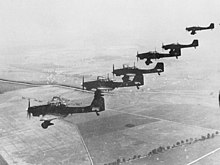The White Eagle
| Movie | |
|---|---|
| Original title | The White Eagle Polish title: Bialy orzel |
| Country of production |
United Kingdom of Poland |
| original language |
English Polish |
| Publishing year | 1942 |
| length | 27 minutes |
| Rod | |
| Director | Eugeniusz Cekalski |
| script | Val Gielgud |
| production | Derrick De Marney |
| music | Bronislaw leader |
| camera |
Ernest Palmer with the support of Cecil Cooney, George V. Plowman, Z. Jaszcz |
| occupation | |
| |
The White Eagle is a 1942 British - Polish documentary directed by Eugeniusz Cekalski.

content
The film tells the story of Poles who found refuge in the United Kingdom . Warsaw street scenes in August 1939 are juxtaposed with street scenes from London . A boy sees German planes in the sky. Shortly afterwards he rings the doorbell of the Polish embassy. The Polish ambassador has an alliance agreement between Poland and Great Britain on his desk. Cut: The Polish officer and Prime Minister of the Polish government-in-exile, Władysław Sikorski, and other officials shake hands to meet at the conference table afterwards. The conference room of the Polish government is in ruins, generals confer in front of large maps, Polish military planes rise into the air. Meanwhile, a doctor examines people at the Polish medical center. Cut: The President of the Polish government in exile Władysław Raczkiewicz meets King Haakon VII of Norway. A little later you can see sketches made by Polish artists, including a caricature by Winston Churchill .
Big Ben can be seen and shortly afterwards the Palace of Westminster . Women are in a Polish library while German planes take off from a French airport elsewhere. Airplanes can be seen in the sky while the air raid siren sounds. Editing: people work in a film cutting room, there are large film cans on the shelves. Explosions can be heard in the distance, fear is spreading that St Paul's Cathedral might be hit. A Polish boy, who is already in bed, counts the bomb explosions, while many houses are already on fire and the fire brigades have little to counter the huge flames. Editing: Big machines appear that print newspapers. Then another air raid, everything is mixed up, the streets are littered with rubble. It shows Polish boys, a Polish bookshop, Polish newspapers, Polish soldiers in Scotland. Then you see a young soldier who lost his leg in Narvik receives an award. Soldiers pose for the camera while people elsewhere move to the rhythm of the Polish folk dance, mazurka . Then airplanes appear in the sky again and King George VI. and his wife Queen Elizabeth can be seen inspecting a Polish army camp in Scotland and then talking to soldiers. Cut: After a ship with Polish sailors on board has been shown, there are further views of naval ships loaded with bombs, shortly afterwards aircraft are fired. A hit airplane falls into the water while diving, waves hit meters high. The other day, Polish President Raczkiewicz and US Ambassador Biddle inspect Polish submarines, pictures of further acts of war, aerial photographs of aircraft and roaring engines. Students from the newly opened Medical School in Edinburgh are also shown during a medical experiment with rats.
People of different nationalities visit the Polish Church in London, sing together and then sink into prayer. Priests hold candles in their hands. Then the picture pans to clouds in the sky and shots echo through the Polish landscape. Then again idyll, a river on which ducks swim, a country farm and back to the city. A reading woman looks at the clock, picks up headphones and then the call can be heard: "London Calling" and a voice announces: "The day will come, the day on which the good news of liberation can be proclaimed." Soldiers load bombs onto planes. The bombs destined for Berlin read Oko Za Oko - an eye for an eye ... Pilots look at a wide map. Smoke rises to the sky and the planes take off. People stick to their headphones so as not to miss an important message. Meanwhile, Polish children run through the streets of London, past destroyed buildings - and in contrast, you can see the branches of a profuse apple tree.
background
The White Eagle is a short film produced by Derrick de Marney and directed by Eugene Cekalski. The story is told by Leslie Howard. Derrick De Marney founded Concanen Film Production with his brother Terence . Alfred Concanen, both grandfathers, had made a name for himself as a Victorian lithographer. He produced several war documentaries, including this one.
The following were involved in the production: Derrick De Marney Productions / Biuro Filmowe Ministerstwa Informacji i Documentacji RP w Londynie. Recording Director: AW Watkins.
Award
The film released by Concanen was nominated for an Oscar in the category “Best Documentary” at the 1943 Academy Awards, but had to take precedence over the productions Battle of Midway , Kokoda Front Line! , Moscow Strikes Back and Prelude to War .
Web links
- The White Eagle in the Internet Movie Database (English)
- The White Eagle film sections (English)
Individual evidence
- ↑ The White Eagle in inafferrabileleslie.wordpress.com (English), accessed on 7 January 2016th
- ↑ The White Eagle at filmaffinity.com, accessed January 7, 2016.